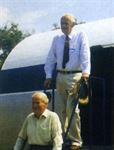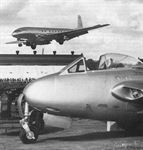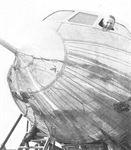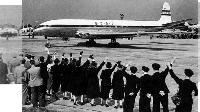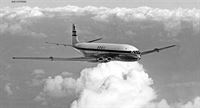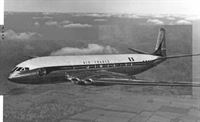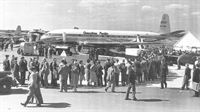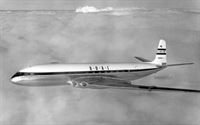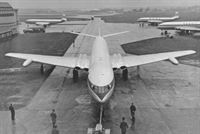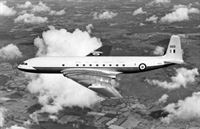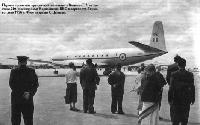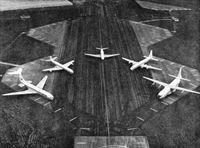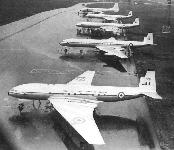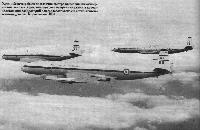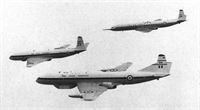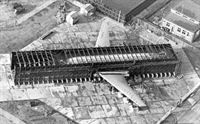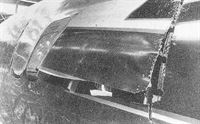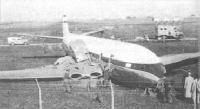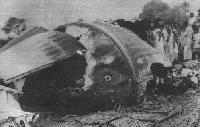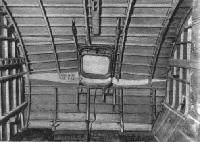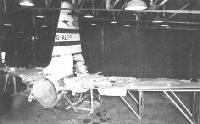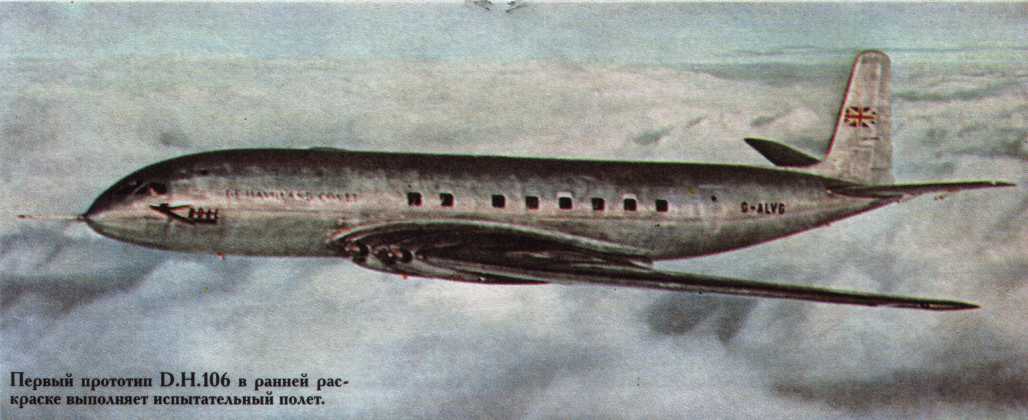
Варианты
- De Havilland - D.H.111 - 1948 - Великобритания
- De Havilland - Comet / D.H.106 - 1949 - Великобритания
- De Havilland - Comet 3 / 4 - 1954 - Великобритания
- Hawker-Siddeley - Nimrod MR.1 / R.1 / MR.2 / HS.801 - 1967 - Великобритания
- BAe - Nimrod AEW - 1980 - Великобритания
- BAe - Nimrod MRA.4 - 2004 - Великобритания
de Havilland DH.106 Comet
Фирма "de Havilland" еще в 1944 году откликнулась на Требование IV комитета лорда Брабазона по созданию послевоенного реактивного самолета. Но только 27 июля 1949 года Джон Каннингхэм впервые поднял в воздух прототип DH.106 Comet с аэродрома в Хэтфилде, продолжительность полета составила всего 31 минуту. Самолет цельнометаллической конструкции с работающей обшивкой и с четырьмя недавно сертифицированными ТРД Ghost 50 Mk 1 тягой 19,79 кН прошел интенсивную программу испытательных полетов, с рядом дальних перелетов. 25 октября 1949 года был совершен перелет по маршруту Лондон - Кастель-Бенито, в начале 1950 года - перелеты Лондон - Рим, Лондон - Копенгаген и Лондон - Каир. Тропические испытания прошли в Хартуме, высотные испытания - в Найроби. Второй прототип взлетел 27 июля 1950 года. В апреле 1951 года машину поставили в авиаотряд "Comet" компании BOAC в Хёрне. Начались полеты в Йоханнесбург, Дели и Сингапур - в рамках 500-часовой программы испытательных полетов и обучения экипажей.
Девять самолетов Comet 1 компании BOAC с многоколесными тележками шасси вместо одноколесных, использовавшихся на двух прототипах, были поставлены с января 1951 по сентябрь 1952 года. В январе 1952 года начались регулярные рейсы в ЮАР (только с грузом), а 22 января был получен сертификат на годность к полетам. 2 мая 1952 года была открыта первая в мире пассажирская авиалиния на реактивных самолетах между Лондоном и Йоханнесбургом. 3 апреля 1953 года лайнеры Comet стали летать на трассе Лондон - Токио. Однако всего лишь месяц спустя, 2 мая 1953 года, самолет Comet трагически разбился при окончательно невыясненных обстоятельствах вскоре после взлета из Калькутты.
После двух подобных катастроф 10 января и 8 апреля 1954 года, когда лайнеры Comet рухнули в Средиземное море, их полеты временно запретили. В последовавшем тщательном расследовании удалось выяснить причину - нарушение герметичности кабины, а уже строившийся для BOAC самолет Comet 2 переделали для службы в британских ВВС. Коммерческое применение серьезно реконструированной версии
Варианты
Comet 1A: в основном аналогичен версии Comet 1, но с увеличенным запасом топлива и воды и с возможностью впрыска смеси воды и метанола в двигатели Ghost 50 Mk 2 тягой 22,24 кН; собраны 10 самолетов, включая по два самолета для компаний "Canadian Pacific Airlines" и канадских ВВС, и по три лайнера для компаний "Air France" и Объединения воздушных и морских перевозок
Comet 2X: планер Comet 1 с турбореактивными двигателями Rolls-Royce Avon Mk 502 тягой 29,36 кН с осевым компрессором; впервые взлетел 16 февраля 1952 года в качестве опытного самолета версии Comet 2
Comet 2: 44-местный лайнер с удлиненным на 0,91 м фюзеляжем и увеличенным запасом топлива для увеличения дальности полета примерно на 563 км, с четырьмя двигателями Avon Mk 503 тягой 32,47 кН; первый из 12 заказанных компанией BOAC взлетел 27 августа 1953 года. После катастроф лайнеров Comet 1 уже построенные планеры переделали - установили круглые иллюминаторы в салоне и усиленную обшивку; 10 самолетов поставили Командованию транспортной авиации британских ВВС - в 216-ю эскадрилью; еще три оснастили специальной электроникой - они служили в 51-й и 192-й эскадрильях 90-й группы; самолеты Comet Mk 2 британских ВВС списаны в апреле 1967 года
Comet 2E: два самолета с двигателями Avon 504 тягой 32,61 кН во внутренних гондолах и двигателями Avon 524 тягой 46,71 кН во внешних гондолах - с 1957-1958 годов летали в компании BOAC для тестовых полетов, что задержало сертификацию и поставки версии Comet 4
Comet 3: впервые взлетел 19 июля 1954 года с двигателем Avon 523 тягой 44,48 кН; в удлиненном на 5,64 м фюзеляже помещалось до 78 пассажиров, дополнительный запас топлива закачивался в крыльевые баки оживальной формы; позднее он служил как опытный самолет для испытаний крыла Comet уменьшенного размаха (со срезанными законцовками)
Comet 4: серийный вариант Comet 3 для полетов над Северной Атлантикой с двигателем Avon 524 тягой 46,71 кН и вместимостью 78 пассажиров; компания BOAC заказала 19 самолетов. Первый Comet 4 поднялся в воздух 27 апреля 1958 года. 4 октября 1958 года была одновременно, с двух сторон, открыта авиалиния, связывающая Лондон и Нью-Йорк. Серийно собрали 27 самолетов, включая шесть машин для компании "Aerolineas Argentinas" и два лайнера для компании "East African Airways"
Comet 4B: проект для авиалиний малой дальности с удлиненным до 35,97 м фюзеляжем и вместимостью 99 пассажиров, с крылом со срезанными законцовками и размахом 32,87 м - без баков оживальной формы. Comet 4B строили для компаний "British European Airways" (14) и "Olympic Airways" (4); первый лайнер взлетел 27 июня 1959 года
Comet 4C: последний серийный вариант - с удлиненным фюзеляжем Comet 4B и крылом Comet 4; первый из трех лайнеров для компании "Mexicana" использовался для сертификации и проверочных полетов и впервые взлетел 31 октября 1959 года; такой самолет также получили компании "Aerolineas Argentinas" (1), "East African Airways" (1), "King Ibn Saud" (1), "Kuwait Airways" (2), "Middle East Airlines" (4), "Misrair" (9), испытательный центр британских ВВС (1), британские ВВС (5) и "Sudan Airways" (2); еще два самолета переделали в прототипы для морских патрульных самолетов Nimrod
- Описание
Фотографии
-
Air Enthusiast 1998-11 / F.Prins - World Beater
Регистрационный номер: G-5-1 [40], G-ALVG [40] DH Comet 1 prototype in 'B' condition markings as G-5-1, Hatfield mid-1949.
-
Air Enthusiast 1998-11 / F.Prins - World Beater
Регистрационный номер: G-ALYP [15] Comet 1 G-ALYP of BOAC, as delivered in April 8, 1952. This aircraft crashed off Elba, Italy, on January 10, 1954.
-
Air Enthusiast 1998-11 / F.Prins - World Beater
Регистрационный номер: F-BGSA [3] Comet 1A F-BGSA of Union Aeromaritime de Transport. Delivered on December 11, 1952, ' SA was withdrawn and put into storage in April 1954 at Le Bourget. It was scrapped in 1961.
-
Aviation Historian 41 / M.Wickstead - French wings over five continents. The story of UTA (1)
Регистрационный номер: F-BGSA [3] The first of UAT’s de Havilland D.H.106 Comet 1As to be delivered, F-BGSA (c/n 6015) made the type’s initial proving flight in UAT service from Paris to Dakar via Casablanca on December 27, 1952, regular services commencing on February 19, 1953.
-
Air International 2007-02 / W.Mellberg - de Havilland D.H.106 Comet /Aircraft profile/
Регистрационный номер: F-BGSB de Havilland DH.106 Comet 1A, F-BGSB, c/n 06016 was delivered in 1953 to French carrier UAT, the first foreign airline to operate the type. Three Comet 2s were also ordered, but never taken up. After the Comet accidents, UAT's first two Comet 1s were withdrawn in 1954: the third aircraft, delivered in April 1953, lasted only two months in service before it skidded off the runway at Dakar, resulting in damage beyond economic repair.
-
Air Enthusiast 1998-11 / F.Prins - World Beater
Comet 1XB 5302 of 412 Squadron, RCAF. Delivered as a Series 1A on April 13,1953, it was converted to 1XB status (oval cabin windows) in September 1957. Retired from RCAF service in 1964, it went on to several civil operators and was scrapped at Miami in late 1975.
-
Air Enthusiast 1998-11 / F.Prins - World Beater
Регистрационный номер: XK697 Comet C.2 XK697 ‘Cygnus’ entered service with 216 Squadron at Lyneham on December 12, 1956, joining 51 Squadron at Wyton in March 1967 and was retired in late 1972.
-
Air International 2007-02 / W.Mellberg - de Havilland D.H.106 Comet /Aircraft profile/
Регистрационный номер: XV144, G-AMXK de Havilland DH.106 Comet 2, XV144, c/n 06033. Like many of the Comet 2s this aircraft had a varied career, starting life as G-AMXK and being used by BOAC for engine trials. After being employed by Smith Industries for automatic landing system development work, it joined the Royal Aircraft Establishment at Bedford in 1966 and was flown by the Blind Landing Experiment Unit. Transferred to Farnborough in 1971, it was withdrawn from service in 1974 and broken up a year later.
-
История Авиации 2000-01 / С.Корж - Неисповедимая судьба "Кометы" /Юбилей/ (1)
Регистрационный номер: G-ALVG [40], G-5-1 [40] Первый прототип D.H.106 в ранней раскраске выполняет испытательный полет.
-
Мировая Авиация 197
Регистрационный номер: G-ALVG [40], G-5-1 [40] Это одна из первых фотографий Comet в воздухе - на фотографии G-ALVG, запечатленный в 1949 году. Видны знаки компании BOAC на носовой части и британский "Юнион Джек" на киле.
-
Aviation Historian 33 / K.Hayward - "A melancholy story of delays, dissapointments and retardations..."
Регистрационный номер: G-5-1 [40], G-ALVG [40] Initially designed to the Committee’s Type IV specification for a high-speed jet-powered mail plane, de Havilland’s D.H.106 was the most ambitious of Britain’s commercial aircraft ventures in the immediate post-war period. Named Comet in December 1947, the prototype, G-5-1 (later G-ALVG), made its first flight on July 27, 1949.
-
История Авиации 2000-01 / С.Корж - Неисповедимая судьба "Кометы" /Юбилей/ (1)
Регистрационный номер: G-ALVG [40], G-5-1 [40] Новая эра в пассажирской авиации началась 25 июля 1949г., когда на испытания вывели первый прототип "Кометы".
-
Aviation Historian 39 / K.Hayward - The De Havilland Comet & the British Government. A life in politics? (1)
Регистрационный номер: G-ALVG [40], G-5-1 [40] In its gleaming natural-metal finish, the prototype Comet is prepared for a flight at Hatfield. The prototype was fitted with four de Havilland Ghost 50 single-stage centrifugal-flow turbojet engines. By the time of the Comet’s first flight, Rolls-Royce’s axial-flow AJ.65, which would become the Avon, was showing promise as a possible replacement for the Ghost. Colour by RICHARD J. MOLLOY
-
Aviation Historian 39 / K.Hayward - The De Havilland Comet & the British Government. A life in politics? (1)
Регистрационный номер: G-ALVG [40], G-5-1 [40] Dawn of a new era - de Havilland technicians prepare the prototype de Havilland D.H.106 Comet on July 26, 1949, for its maiden flight the following day. Photographic colourisation by RICHARD J. MOLLOY.
-
Air Pictorial 1999-07 / ??? - Comet - a golden anniversary!
Two of BOAC’s Comet Is at Johannesburg’s Palmietfontein Airport in May 1952;
-
Air Pictorial 1999-07 / ??? - Comet - a golden anniversary!
Регистрационный номер: G-ALVG [40], G-5-1 [40] Painted in BOAC colours, G-ALVG appeared at Farnborough in September 1949.
-
Air Pictorial 1995-04 / A.Jackson - Comet I - Success and Disaster
Регистрационный номер: G-ALVG [40], G-5-1 [40] Prototype Comet I in BOAC colours.
-
Air Pictorial 1999-07 / ??? - Comet - a golden anniversary!
The DH Gazette of June 1951, proudly illustrated the first three aircraft during their flight test programme.
-
Air International 2007-02 / W.Mellberg - de Havilland D.H.106 Comet /Aircraft profile/
Comet 1XB, 5302, of the Royal Canadian Air Force's 412 Squadron, pictured at Dusseldorf in 1962. This aircraft was originally a 1A, but was modified to the later standard featuring oval windows and strengthened cabin structures.
-
Aviation Historian 39 / K.Hayward - The De Havilland Comet & the British Government. A life in politics? (1)
Регистрационный номер: G-ALYT [3] A rare colour photograph of G-ALYT in flight, powered by its four Avon Mk 502 engines. The sixth Comet 1 built, ’LYT was retained by the Ministry of Supply as the sole Comet 2X and used by BOAC for tropical trials in May 1953. It was withdrawn from use in 1954 and went on to be an instructional airframe at Halton during 1959-67.
-
Aviation Historian 41 / K.Hayward - The De Havilland Comet & the British Government. Back in business (3)
Регистрационный номер: XK695 [3], G-AMXH [3] The Comet 2s originally intended for BOAC ultimately went to the RAF, Transport Command receiving 15 examples, designated Comet C.2s. Originally G-AMXH when it first flew in August 1956, XK695 (named Perseus in RAF service) joined No 216 Sqn - the world’s first military jet transport unit - at RAF Lyneham later that year.
-
Aeroplane Monthly 1999-11
John Wilson (top) and John Cunningham step out of the transformed Comet fuselage at Salisbury Hall.
-
Aeroplane Monthly 1996-03 / M.Oakey - Vintage news
Регистрационный номер: XK695 [3], G-AMXH [3] The nose section of D.H. Comet 2H XK695 at the Mosquito Aircraft Museum.
-
Aeroplane Monthly 2000-01 / P.Jarrett - Landmarks in the sky /Epoch-making aircraft/
Регистрационный номер: G-ALVG [40], G-5-1 [40] The de Havilland D.H.106 Comet entered the record books as the world's first turbojet-powered commercial airliner. Rolled out in April 1949, the first prototype G-5-1/G-ALVG first flew on July 27, 1949, under the power of four 4,450lb-thrust de Havilland Ghost 50s. The first production aircraft flew on January 1, 1950, and British Overseas Airways Corporation began regular operations on May 2, 1952.
-
Мировая Авиация 85
Регистрационный номер: G-ALVG [40], G-5-1 [40] Полет первого реактивного авиалайнера. 27 июля 1949г.: с заводского аэродрома в Хэтфилде под управлением летчика-испытателя Джона Каннингхема, бывшего аса, совершил первый полет прототип de Havilland DH.106 Comet I (G-ALVG, на фото). Самолет имел крейсерскую скорость 789 км/час и стал первым в мире реактивным пассажирским авиалайнером, вышедшим на регулярные маршруты (в мае 1952 года, авиакомпания BOAC). Однако ряд аварий и катастроф в 1953-1954 годах привели к длительному запрету на полеты и необходимости доработать конструкцию машины. Впоследствии прототип использовался для испытаний ракетных ускорителей de Havilland Sprite - первый взлет с ними самолет совершил в мае 1951 года. Затем машину передали для конструкционных испытаний, а в июле 1953 года в Фарнборо ее утилизировали.
-
Aviation Historian 39 / K.Hayward - The De Havilland Comet & the British Government. A life in politics? (1)
Регистрационный номер: G-5-1 [40], G-ALVG [40] The jewel in the crown of the programme established in the wake of the Brabazon Committee’s final report on the future of British civil aviation in December 1945, the de Havilland D.H.106 Comet represented a quantum leap in airliner technology. Here, the prototype is seen up from Hatfield in the second half of 1949 with its original B Conditions registration, G-5-1.
-
Aeroplane Monthly 1989-08 / J.Ramsden - Wings of change (1)
Регистрационный номер: G-5-1 [40], G-ALVG [40] The prototype Comet flying over England's green and pleasant land in August 1949.
-
Авиация и Космонавтика 2024-07 / Некоторые знаменательные даты июля в истории авиации
Регистрационный номер: G-ALVG [40], G-5-1 [40] -
Air Enthusiast 2003-07 / Round-Out
Регистрационный номер: G-ALVG [40], G-5-1 [40] View of Comet G-ALVG
-
Aeroplane Monthly 1989-08 / J.Ramsden - Wings of change (1)
Регистрационный номер: G-ALVG [40], G-5-1 [40] The Comet prototype flying in early BOAC livery in January 1950.
-
Aeroplane Monthly 1989-08 / J.Ramsden - Wings of change (1)
Регистрационный номер: G-ALVG [40], G-5-1 [40] An early view of the Comet prototype in flight. Note how the four D.H. Ghost turbojets are grouped as close as possible to the fuselage centreline, making asymmetric flying less of a problem.
-
Aeroplane Monthly 1994-11 / J.Maynard - John Cunningham (3)
Регистрационный номер: G-ALVG [40], G-5-1 [40] The Comet prototype, with Cunningham at the helm, arriving at the 1949 SBAC show at Farnborough on September 6. In the foreground is G-5-2, the Vampire NF.10 prototype in which Geoffrey Pike had made the maiden flight less than a fortnight earlier.
Другие самолёты на фотографии: De Havilland Vampire / D.H.100 - Великобритания - 1943
-
Aeroplane Monthly 1988-05 / J.Maynard - DH Apprentice (2)
Регистрационный номер: G-ALVG [40], G-5-1 [40] The prototype D.H.106 Comet sweeps into Hatfield across Manor Road on its return from a test flight to Rome in the hands of John Cunningham on March 16, 1950.
-
Air Pictorial 1999-07 / ??? - Comet - a golden anniversary!
Регистрационный номер: G-ALVG [40], G-5-1 [40] The prototype Comet, G-ALVG/G-5-1, which made aviation history on the evening of July 27, 1949, when it completed its 31 minute first flight.
-
Aeroplane Monthly 1988-09 / Farnborough 1949
Регистрационный номер: G-ALVG [40], G-5-1 [40] All heads turn to watch the arrival of the world’s first four-jet airliner as John Cunningham, de Havilland chief test pilot, brings in the prototype Comet 1 G-ALVG. The four 5,000lb-thrust de Havilland Ghost engines emit a low whistle as the 36-passenger airliner drops onto its two large-diameter mainwheels. It was the Comet’s first public appearance, the first flight having been made on July 27, 1949, from Hatfield.
-
Air Pictorial 1995-04 / A.Jackson - Comet I - Success and Disaster
Регистрационный номер: G-ALZK [5] G-ALZK, the second aircraft, takes off on its initial flight on July 27, 1950.
-
Aeroplane Monthly 1989-09 / J.Ramsden - Wings of change (2)
Регистрационный номер: G-ALVG [40], G-5-1 [40] The prototype Comet seen during trials following the replacement of the single mainwheel undercarriage with four-wheel bogies. Although the bogies reduced the Comet’s fuel capacity - by 6 1/2 gal on each side! - they weighed less than the single mainwheels.
-
Air Enthusiast 1998-11 / F.Prins - World Beater
Регистрационный номер: G-ALVG [40], G-5-1 [40] A pleased John Cunningham pops his head out of the cockpit of G-ALVG just after the first flight.
-
Aeroplane Monthly 1989-08 / J.Ramsden - Wings of change (1)
Регистрационный номер: G-ALVG [40], G-5-1 [40] John Cunningham with his crew surrounded by D.H. experimental shop “hands” after the Comet’s first flight, on July 27, 1949.
-
Aeroplane Monthly 1994-11 / J.Maynard - John Cunningham (3)
John Cunningham, Sir Frank Whittle and Maj F.B. Halford gathered beneath the tail of the prototype Comet airliner at Hatfield.
-
Aeroplane Monthly 1994-12 / J.Maynard - John Cunningham (4)
John Cunningham on his return from a record flight from Hatfield to Rome and back in a little over four flying hours, made in the Comet prototype on March 16, 1950.
-
Aeroplane Monthly 1989-08 / J.Ramsden - Wings of change (1)
Ronald E. Bishop, head of the team which designed the Comet airliner.
-
Aeroplane Monthly 1989-08 / J.Ramsden - Wings of change (1)
A signwriter applies the famous name to the prototype.
-
Jane's All the World Aircraft 1980 / Encyclopedia of Aviation - 1. Chronology
Регистрационный номер: G-ALVG [40], G-5-1 [40] Prototype Comet 1 (27 July 1949).
-
Aeroplane Monthly 1994-11 / J.Maynard - John Cunningham (3)
Регистрационный номер: G-5-1 [40], G-ALVG [40] Hatfield on July 27, 1949; John Cunningham’s 32nd birthday and a milestone in his flying career. There on the Hatfield apron is G-5-1, the prototype Comet, awaiting its maiden flight. Later that day, at 1817hr, Cunningham and his crew of four took off from Hatfield and completed a trouble-free 35min first flight away from the eyes of the press.
-
Aeroplane Monthly 1989-08 / J.Ramsden - Wings of change (1)
Регистрационный номер: G-5-1 [40], G-ALVG [40] The prototype Comet in Class B markings G-5-1 at Hatfield at the time of its first flight. The 31 min maiden flight was made by John Cunningham on July 27, 1949. Note the huge single mainwheels.
-
Air Enthusiast 1998-11 / F.Prins - World Beater
Регистрационный номер: G-ALVG [40], G-5-1 [40] The prototype, G-ALVG bearing BOAC markings on the nose, arriving at Copenhagen during the record-breaking route proving runs.
-
Air Enthusiast 2003-07 / Round-Out
Регистрационный номер: G-ALVG [40], G-5-1 [40] View of Comet G-ALVG
-
Aeroplane Monthly 1989-08 / J.Ramsden - Wings of change (1)
Регистрационный номер: G-ALVG [40], G-5-1 [40] The prototype Comet painted in the new BOAC livery in April 1950. After flying with Sprite assisted take-off equipment in 1951, 'VG was scrapped at Farnborough in July 1953.
-
Aeroplane Monthly 1994-12 / J.Maynard - John Cunningham (4)
Регистрационный номер: G-ALVG [40], G-5-1 [40] Comet prototype G-ALVG at the 1950 Farnborough show in BOAC livery.
-
Aeroplane Monthly 1993-10 / T.Nelson - Falling stars (1)
Регистрационный номер: G-ALYV First flown on April 9, 1952, from Hatfield, Comet 1 G-ALYV had been in service with BOAC less than a year when it was lost in a crash near Calcutta on May 2, 1953.
-
История Авиации 2000-01 / С.Корж - Неисповедимая судьба "Кометы" /Юбилей/ (1)
Регистрационный номер: G-ALYP [15] Первая серийная "Комета" (борт G-ALYP) "Старина Питер" в аэропорту Йоханнесбурга в преддверии открытия регулярной эксплуатации.
-
Авиация и Космонавтика 2007-04 / Знаменательные даты весны 2007г. в области авиации
Регистрационный номер: G-ALYP [15] Рождение реактивного "транспортника". 2 мая 1952г.: de Havilland Comet I, первый реактивный пассажирский лайнер, получивший сертификат летной годности (22 января), вышел на линию Лондон - Йоханнесбург компании BOAC. Начались первые регулярные полеты реактивных авиалайнеров. Первый рейс совершил самолет G-ALYP, который из Лондона до Бейрута пилотировал А.М.А.Мадженди, от Бейрута до Хартума - Дж.Т.Э.Марсден, а между Хартумом и Йоханнесбургом - через Энтеббе и Ливингстоун - Р.К.Алабастер. Расстояние в 10821 км было преодолено за 23 ч 34 мин.
Departure of the first BOAC Comet scheduled passenger flight. -
Air Enthusiast 2003-05 / Round-Out
Регистрационный номер: G-ALVG [40], G-5-1 [40] First prototype DH Comet at Farnborough, near the golf course end. Photo shows a Comet with single mainwheels yet it has 'slipper' wing tanks. Look at the engine intakes, the intake visible on the starboard side is different from the port.
-
Aviation Historian 40 / K.Hayward - The De Havilland Comet & the British Government. The knife's edge (2)
With the Comet Mk 1, BOAC could legitimately claim to be a ‘‘world leader in air travel", as this brochure claimed - but as BOAC Chairman Sir Miles Thomas said of the 1954 crashes: “All my aspirations and expectations had fallen out of the sky”.
-
Aeroplane Monthly 1993-11 / T.Nelson - Falling stars (2)
Регистрационный номер: G-ALYY Comet 1 G-ALYY at Frankfurt-Main on April 21, 1953. First flown on September 9, 1952, this aircraft crashed into the Tyrrhenian Sea north of Stromboli on April 8, 1954.
-
Air Pictorial 1977-12 / J.Hunt - Aviation in the Sudan - before independence
Регистрационный номер: G-ALYU [4] BOAC started jet services through Khartoum with de Havilland Comets in May 1952. Shown here is Comet G-ALYU with members of the Sudanese Camel Corps
-
Aeroplane Monthly 1993-11 / T.Nelson - Falling stars (2)
Регистрационный номер: G-ALYP [15] The ill-fated first production Comet 1, G-ALYP, at the time of its first flight in January 1951.
-
Aeroplane Monthly 1981-03 / News Spotlight
Регистрационный номер: G-APAS, XM823 Seen at RAF Cosford is the D.H. Comet 1A G-APAS, ex XM823/8351M, painted in BOAC livery.
-
История Авиации 2000-01 / С.Корж - Неисповедимая судьба "Кометы" /Юбилей/ (1)
Демонстрируя надежность и веру в изделие английских самолетостроителей, королева Елизавета совершила на "Кометах" авиакомпании BOAC несколько вояжей за рубеж. На приведенном снимке "Комета"1 доставила Ее Величество в Эмбакаси.
-
Aeroplane Monthly 1989-09 / J.Ramsden - Wings of change (2)
Регистрационный номер: G-ALWY Royal approval The Queen Mother and Princess Margaret leave Comet I G-ALWY at Heathrow having arrived from Salisbury, Rhodesia on July 17, 1953.
-
Aeroplane Monthly 1993-10 / T.Nelson - Falling stars (1)
Регистрационный номер: G-ALYZ [3] Ill-fated Comet 1 G-ALYZ pictured at Hatfield on September 22, 1949 the day before its first flight.
-
Air Enthusiast 2003-07 / Round-Out
Регистрационный номер: G-ALVG [40], G-5-1 [40] View of Comet G-ALVG
-
Aeroplane Monthly 1994-12 / J.Maynard - John Cunningham (4)
Регистрационный номер: G-ALVG [40], G-5-1 [40] G-ALVG, the prototype Comet, leaps away assisted by Sprite rockets installed between the Ghost tailpipes.
The de Havilland Sprite rocket motor produced 5,000lb thrust; two were installed on the Comet prototype G-ALVG for flight trials beginning in May 1951. -
Aviation Historian 39 / K.Hayward - The De Havilland Comet & the British Government. A life in politics? (1)
Регистрационный номер: G-ALVG [40], G-5-1 [40] The prototype, registered G-ALVG and resplendent in BOAC colours, up from Farnborough during the SBAC show in September 1950. The new jetliner was streets ahead of any other airliner then available, but its success was dependent on a series of government interventions that would have far-reaching consequences.
-
Aeroplane Monthly 1993-11 / T.Nelson - Falling stars (2)
Регистрационный номер: G-ALYP [15] The first production Comet 1, G-ALYP, was delivered to BOAC in March 1952.
-
Aeroplane Monthly 1994-12 / J.Maynard - John Cunningham (4)
Регистрационный номер: G-ALYP [15] On May 2, 1952, Comet G-ALYP took the first fare-paying passengers from London to Johannesburg. On January 10, 1954, 'YP hit the headlines again, when it suffered catastrophic failure, the wreckage falling into the sea off Elba.
‘Yoke Peter’, the first production aircraft which was lost off Elba in 1954. -
Air Enthusiast 1998-11 / F.Prins - World Beater
Регистрационный номер: G-ALVG [40], G-ALZK [5], G-5-1 [40] The prototype Comet, G-ALVG, in formation with the second aircraft, G-ALZK.
-
Мировая Авиация 67
Регистрационный номер: G-ALYP [15] 10 января 1954г.: самолет de Havilland Comet I (G-ALYP) потерпел катастрофу в Средиземном море в районе острова Эльба; погибли все 35 человек, находившиеся на его борту.
-
Aeroplane Monthly 1993-10 / T.Nelson - Falling stars (1)
Регистрационный номер: G-ALVG [40], G-ALYP [15], G-ALZK [5], G-5-1 [40] The first three completed Comet Is in formation early in 1951. The first production aircraft, G-ALYP, is nearest the camera. It was lost in the sea off Elba on October 1, 1954. Comet prototype G-ALVG is in the centre and G-ALZK completes the trio.
-
Мировая Авиация 197
Регистрационный номер: G-ALVG [40], G-ALYP [15], G-ALZK [5], G-5-1 [40] Первые три Comet I компании BOAC. На переднем плане запечатлен G-ALYP, первый реактивный авиалайнер, вышедший 2 мая 1953 года на коммерческий маршрут из Лондона в Йоханнесбург.
-
Aeroplane Monthly 1989-08 / J.Ramsden - Wings of change (1)
Регистрационный номер: G-ALVG [40], G-ALYP [15], G-ALZK [5], G-5-1 [40] The first three completed Comets airborne together in March 1951. Nearest the camera is the first production Comet, G-ALYP. The two prototypes, G-ALVG and G-ALZK, cruise discreetly in the background.
-
Aviation Historian 40 / K.Hayward - The De Havilland Comet & the British Government. The knife's edge (2)
Регистрационный номер: F-BGNX Авиакомпания "Эйр Франс" в 1951г. заказала три "Кометы"1A, отличавшиеся от стандартной "единички" увеличенным до 44 мест пассажирским салоном и более экономичными двигателями, что позволило увеличить дальность полета на 30%.
Keen to capitalise on the prestige of the Comet and its sparkling performance, two French airlines acquired three Comet 1As each during 1952-53: Union Aeromaritime de Transport (UAT) and Air France. The latter’s first example, F-BGNX, seen here, operated on the airline’s Paris-Rome-Beirut service from the summer of 1953. -
Мировая Авиация 197
"Air France" приступила к эксплуатации Comet 26 августа 1953 года на маршруте Париж - Рим - Бейрут, но после лишения в апреле 1954 года самолета сертификата летной годности компания больше его не использовала.
-
Air Enthusiast 1998-11 / F.Prins - World Beater
Регистрационный номер: F-BGNY Series 1A F-BGNY of Air France at Hatfield, prior to delivery. It flew the first Air France turbojet service on August 26, 1953. DH bought ’NY back in April 1954 and it later joined the Ministry of Aviation test fleet as a Series 1XB.
-
Air Pictorial 1995-04 / A.Jackson - Comet I - Success and Disaster
Регистрационный номер: F-BGSA [3] In February 1953, F-BGSA began regular services between Paris, Casablanca and Dakar.
-
Air Pictorial 1995-04 / A.Jackson - Comet I - Success and Disaster
Регистрационный номер: CF-CUM [2] Canadian Pacific received two Comets, CF-CUM later returning to BOAC.
-
Air Enthusiast 1998-11 / F.Prins - World Beater
Регистрационный номер: CF-CUM [2] Canadian Pacific’s 1A CF-CUM ‘Empress of Vancouver’ at the SBAC display at Farnborough, September 1952 with a huge queue waiting to inspect the interior. CPA did not operate the aircraft, it was passed on to BOAC in August 1953.
-
Aeroplane Monthly 1993-10 / T.Nelson - Falling stars (1)
Регистрационный номер: CF-CUN [2] Canadian Pacific Comet 1A CF-CUN Empress of Hawaii was destroyed at Karachi while on its delivery flight on March 3, 1953.
-
Мировая Авиация 197
Регистрационный номер: CF-CUN [2] "Canadian Pacific" имела в начале 1950-х годов два самолета Comet Series 1A - CF-CUM и CF-CUN (на фотографии). Первый был передан BOAC, где получил регистрацию G-ANAV, a CF-CUN потерпел аварию во время взлета.
-
История Авиации 2000-01 / С.Корж - Неисповедимая судьба "Кометы" /Юбилей/ (1)
"Комета"1A из состава Королевских ВВС Канады (RCAF).
-
Air Pictorial 1995-04 / A.Jackson - Comet I - Success and Disaster
After modification to IXB standard, the two RCAF Comets went on to give some years of reliable service.
-
Air Enthusiast 2007-03 / D.Willis - Extended Family /Post-war combat/ (3)
The RCAF operated two Comets, though it used them only briefly
-
Мировая Авиация 197
Регистрационный номер: G-ALYT [3] Компания "de Havilland" в рамках совершенствования самолета решила на новом поколении, Comet 2, установить двигатели Rolls-Royce Avon. Последние были опробованы на прототипе Comet 2X (G-ALYT), совершившем первый полет 16 февраля 1952 года.
-
Aviation Historian 40 / K.Hayward - The De Havilland Comet & the British Government. The knife's edge (2)
Регистрационный номер: G-AMXA [3], XK655 [3] The first production Comet 2, G-AMXA, made its first flight on August 27, 1953, the new variant incorporating fuselage pressure shells of heavier-gauge metal, rounded apertures and modified engine jetpipes swept outwards to reduce fuselage buffeting. All 12 Comet 2s ultimately went to the RAF, G-AMXA becoming XK655.
-
История Авиации 2000-01 / С.Корж - Неисповедимая судьба "Кометы" /Юбилей/ (1)
Регистрационный номер: G-AMXA [3], XK655 [3] Первый полет серийной "Кометы"2. Экипаж возглавляет Джон Кэннингхэм. 27 августа 1953г.
-
Air Pictorial 1995-04 / A.Jackson - Comet I - Success and Disaster
Регистрационный номер: G-AMXD [4], XN453 [4] Recovering from the publicity, de Havilland showed the Comet II G-AMXD and the improved III G-ANLO at the 1954 SBAC Show at Farnborough.
-
Aviation Historian 39 / K.Hayward - The De Havilland Comet & the British Government. A life in politics? (1)
Регистрационный номер: G-AMXD [4], XN453 [4] The shape of things to come - this 1954 de Havilland promotional photograph shows Comet 2 G-AMXD (which became XN453 in RAF service) in the background accompanying the sole Comet 3, G-ANLO. The latter was lengthened by 15ft 5in (4-7m) and fitted with wing-mounted pinion fuel tanks for increased range performance.
Другие самолёты на фотографии: De Havilland Comet 3 / 4 - Великобритания - 1954
-
Aviation Historian 41 / K.Hayward - The De Havilland Comet & the British Government. Back in business (3)
With three Comet 2s in the background, Comet 3 G-ANLO is towed on to the distinctive apron at Hatfield in May 1954. The new variant’s pinion tanks fitted at two-thirds span are clearly visible. Initially fitted with 10,000lb (44kN)-thrust Avon 502 engines, G-ANLO had these replaced with more powerful hush-kitted Avon RA.29s in 1957.
Другие самолёты на фотографии: De Havilland Comet 3 / 4 - Великобритания - 1954
-
Aviation Historian 39 / K.Hayward - The De Havilland Comet & the British Government. A life in politics? (1)
Регистрационный номер: XK669 [3] The Comet not only ushered in the jet era in terms of commercial transport, but also pioneered the use of jet aircraft in the military transport role. Ultimately, all 15 of the Avon-powered Comet 2s built entered service with RAF Transport Command, No 216 Sqn becoming the world’s first military jet transport unit in the summer of 1956.
-
Air Pictorial 1958-10
Will you fly Comets? This Comet 2 has a stage length of more than 2,200 miles against a 50 m.p.h. headwind. The cruising speed is 480 m.p.h. and the cruising altitude is 35-40,000 ft. The Comets provide the R.A.F. with that essential quality of mobility so vital in air strategy today.
-
Air Enthusiast 1998-11 / F.Prins - World Beater
Регистрационный номер: XK671 THE DE HAVILLAND COMET 2 in service with ROYAL AIR FORCE TRANSPORT COMMAND js powered by ROLLS-ROYCE AVON TURBO JETS
Superb portrait of Comet C.2 XK671. Delivered to the RAF in August 1956, it served with 216 Squadron as ‘Aquila’ until September 1962 and was retired in 1966.
In 1956 No 216 Squadron RAF became the world’s first military jet transport squadron. It was equipped with Comet C.2s of which XX671, seen here, was an early example. The squadron’s first operational flight was made on June 23, 1956, when one of the unit’s Comets flew the Air Minister to Moscow for Soviet Air Force Day. XK671 was later named Aquila. -
Air-Britain Aeromilitaria 1984-01
Landing at Bahrain with forces for the build-up is a Comet C.2 of No.216 Squadron
-
Air Pictorial 1995-04 / A.Jackson - Comet I - Success and Disaster
Регистрационный номер: XK669 [3] After the accidents, plans to operate Comet IIs commercially were dropped, those aircraft that had been built being modified for use by RAF Transport Command. XK669 was one of ten operated by No 216 Sqn.
-
Мировая Авиация 152
Регистрационный номер: XK659 Британская разведка. Как и ВВС США, в начале 1960-х годов британские ВВС имели свой парк самолетов РТР, включая Comet R.Mk 2 (фото) и Canberra B.Mk 6 (mod) из 51-й эскадрильи. Оба типа были приняты на вооружение в 1958 году и неоднократно проходили доработки. Comet и Canberra регулярно появлялись на авиабазе Акротири на Кипре. Отсюда они совершали полеты к южным рубежам Советского Союза, а также отслеживали потенциальных противников на Ближнем Востоке.
-
Aviation Historian 40 / K.Hayward - The De Havilland Comet & the British Government. The knife's edge (2)
Регистрационный номер: XK695 [3], G-AMXH [3] Comet 2 G-AMXH made its first flight on August 21, 1956, but was not certificated and was converted into a Comet C.2 for the RAF, for which it served as XK695, joining No 216 Sqn at Lyneham later that year. With the Comet 2s hived off to the RAF, de Havilland turned its attention to developing the Comet 3 into the definitive variant, the Comet 4.
-
История Авиации 2000-02 / С.Корж - Неисповедимая судьба "Кометы" /Юбилей/ (2)
Регистрационный номер: XK670 Первые признаки хрущевской оттепели: "Комета"T.2 из состава 216-й эскадрильи Королевских ВВС в аэропорту Внуково, лето 1956г.
-
Air Pictorial 1977-05 / T.Norman - Strathallan Collection
Регистрационный номер: XK655 [3], G-AMXA [3] The Strathallan Collection includes a fair cross-section of de Havilland types: Comet C.2 G-AMXA/XK655
-
Air-Britain Aeromilitaria 1978-04
VC10, Comet C.4, Comet C.2, Britannia C.I and Belfast C.I on the parking pan at Brize
Другие самолёты на фотографии: Bristol Britannia / Type 175 - Великобритания - 1952De Havilland Comet 3 / 4 - Великобритания - 1954Short SC.5 Belfast - Великобритания - 1964Vickers VC-10 - Великобритания - 1962
-
Air Pictorial 1999-07 / ??? - Comet - a golden anniversary!
Регистрационный номер: XK669 [3] July 30, 1962, was a wet day, but undeterred, No 216 Sqn displayed its new C.4s alongside a C.2 (XK669) and a Bristol Britannia at RAF Lyneham.1
Другие самолёты на фотографии: Bristol Britannia / Type 175 - Великобритания - 1952De Havilland Comet 3 / 4 - Великобритания - 1954
-
История Авиации 2000-03 / С.Корж - Неисповедимая судьба "Кометы" /Юбилей/ (3)
Регистрационный номер: XN453 [4], G-AMXD [4] Хотя "Кометы" были достаточно быстро выведены из коммерческой эксплуатации, они еще долгое время служили в качестве летающих лабораторий в исследовательском и летно-испытательном центрах Королевских ВВС.
Другие самолёты на фотографии: De Havilland Comet 3 / 4 - Великобритания - 1954
-
Air International 1994-08 / A.Pearcy - A look back at Bedford
Регистрационный номер: XN453 [4], G-AMXD [4] This unique formation of Comet research aircraft took place on March 29, 1972, near Bedford. Leading the trio is XN453 ex G-AMXD c/n 06026, in the background is XP915 the only Comet 3 ex G-ANLO c/n 06100 transferred to the BLEU at Bedford on June 21, 1961, and in use until March 1972. Nearest the camera is XV814 ex G-APDF c/n 06407.
Другие самолёты на фотографии: De Havilland Comet 3 / 4 - Великобритания - 1954
-
История Авиации 2000-01 / С.Корж - Неисповедимая судьба "Кометы" /Юбилей/ (1)
Одним из отличий "двойки" от "единички" стали более глубокие воздухозаборники двигателей "Эвон"R.A.25 (Mk.503, Mk.504).
-
Aviation Historian 39 / K.Hayward - The De Havilland Comet & the British Government. A life in politics? (1)
The fitting of Avons required the enlargement of the air intakes in the wing roots, as seen in this photo of G-ALYT.
-
Aeroplane Monthly 1989-09 / J.Ramsden - Wings of change (2)
Early Comets were powered by four 5,000lb-thrust turbojet engines buried in the wing roots. The Comet 4 series had double this power and were fitted with four Rolls-Royce.
-
Aviation Historian 39 / K.Hayward - The De Havilland Comet & the British Government. A life in politics? (1)
Регистрационный номер: G-ALYT [3] One of the Avon engines fitted to Comet 1 G-ALYT during the latter’s construction; this led to the aircraft being designated the Comet 2X, which made its first flight on February 16, 1952.
-
Aeroplane Monthly 1989-08 / J.Ramsden - Wings of change (1)
Early Comets were powered by four 5,000lb-thrust turbojet engines buried in the wing roots.
-
Air Enthusiast 1998-11 / F.Prins - World Beater
The prototype DH.106 under construction at Hatfield.
-
Jane's All the World Aircraft 1980 / Encyclopedia of Aviation - Aircraft A-Z - v3
The night shift continues work on the prototype de Havilland D.H.106 Comet.
-
Aeroplane Monthly 1989-09 / J.Ramsden - Wings of change (2)
Early Comets under construction at Hatfield. A notice in the roof says: “Sheet metal must be handled with care to avoid scratching the surface”.
-
Aeroplane Monthly 1997-03 / J.Stroud - Tamblin's Tram
Two Heron Is in the Hatfield assembly shop in January 1952. A Comet’s nose is visible in the background.
Другие самолёты на фотографии: De Havilland Heron / D.H.114 - Великобритания - 1950
-
Aeroplane Monthly 1988-05 / J.Maynard - DH Apprentice (2)
In this photograph of one of the Hatfield aircraft assembly halls can be seen Chipmunks, Comets, Vampires and Venoms.
Другие самолёты на фотографии: De Havilland Vampire / D.H.100 - Великобритания - 1943De Havilland Venom / D.H.112 - Великобритания - 1949De Havilland Canada DHC-1 Chipmunk - Канада - 1946
-
Aeroplane Monthly 1988-04 / J.Maynard - DH Apprentice (1)
This photograph of Comet 1 production at Hatfield was taken five months before the maiden flight of the prototype. The 31 min first flight took place on July 27, 1949 in private and without the press in attendance.
-
Aeroplane Monthly 1988-05 / J.Maynard - DH Apprentice (2)
The “coffin-like” box from which the author had a riveting experience with production Comets.
-
Aeroplane Monthly 1993-10 / T.Nelson - Falling stars (1)
A Comet under construction at Hatfield in 1952, showing the rear of the pressurised fuselage about to be mated with the tail section.
-
Aviation Historian 40 / K.Hayward - The De Havilland Comet & the British Government. The knife's edge (2)
Регистрационный номер: G-ALYU [4] In the wake of the BOAC Comet crashes in January and April 1954, Comet 1 G-ALYU was used for testing in a tank at the RAE at Farnborough, in which water was used to simulate cabin loading in flight and hydraulic rams were used to simulate loading on the wings. The loads applied simulated a three-hour flight in ten minutes.
-
Aeroplane Monthly 1993-11 / T.Nelson - Falling stars (2)
Регистрационный номер: G-ALYU [4] An aerial view of the Hatfield water tank in December 1955. The filled section, containing the Comet 2 fuselage, held 220,000 gal of water. The empty end portion had a capacity of 70,000 gal. A reservoir of 330,000 gal may be seen in the bottom right-hand corner.
-
Air Enthusiast 1998-11 / F.Prins - World Beater
To test the steering, a Comet nosewheel was fitted to a converted lorry chassis with bomber (Halifax?) mainwheels to stop the unit overturning. The figure on the right, wearing the hat, is Sir Geoffrey de Havilland.
-
Aeroplane Monthly 1989-08 / J.Ramsden - Wings of change (1)
The prototype Comet's cockpit, an essay in functional neatness and simplicity. The small group of engine instruments is located in the centre of the fascia panel, with the four throttles immediately below. The two sets of levers at the bottom of the central console are fuel cocks.
-
Aeroplane Monthly 1994-12 / J.Maynard - John Cunningham (4)
John Cunningham with Peter Bugge, de Havilland chief development test pilot, in the cockpit of a Comet.
-
Aeroplane Monthly 1993-11 / T.Nelson - Falling stars (2)
Comfort, coupled with efficiency and economy, was the hallmark of the Comet’s passenger cabin and seating. The failure of early Comet fuselages started at windows identical to the one seen here.
-
Aeroplane Monthly 1993-11 / T.Nelson - Falling stars (2)
Reduxed window frame of a Comet 1 during construction in 1951. Rivets mean holes, and holes mean leaks, and Comet designer R. E. Bishop originally decided on extensive Redux bonding, which saved the weight of rivets and allowed the use of thinner plate. A combination of riveting and bonding was used on the Comet.
-
Aeroplane Monthly 1989-09 / J.Ramsden - Wings of change (2)
A BOAC Comet seen after it ran off the runway at Dum Dum Airport, Calcutta in 1953.
-
Aeroplane Monthly 1989-08 / J.Ramsden - Wings of change (1)
In June 1953, six months before the first comet cabin failed in flight, a test section at Hatfield had been given 16,000 fatigue cycles before failure. The actual cabin failure occurred at around 1,000 fatigue cycles.
-
Air Enthusiast 1998-11 / F.Prins - World Beater
The Farnborough Comet 1 fuselage fails after the equivalent of 9,000 flying hours.
-
Aeroplane Monthly 1994-02 / R.Dennis - Farnborough's caterpillars (2)
A 1954 photograph showing metal fatigue/stress failure of a Comet airliner pressure cabin at Farnborough.
-
Aeroplane Monthly 1989-09 / J.Ramsden - Wings of change (2)
Регистрационный номер: G-ALYZ [3] Comet G-ALYZ seen at Ciampino Airport, Rome on October 26, 1952 after over-rotating.
-
Air Pictorial 1995-04 / A.Jackson - Comet I - Success and Disaster
Регистрационный номер: G-ALYZ [3] Comet G-ALYZ after the accident at Rome in October 1952.
-
История Авиации 2000-01 / С.Корж - Неисповедимая судьба "Кометы" /Юбилей/ (1)
Обломки разбившейся 2 мая 1953г. "Кометы" были разбросаны на площади почти в 20 кв.км в 40 км северо-западнее Калькутты.
-
История Авиации 2000-01 / С.Корж - Неисповедимая судьба "Кометы" /Юбилей/ (1)
Регистрационный номер: G-ALYU [4] Трещины в обшивке "Кометы"1 авиакомпании BOAC (рег. код G-ALYU), полученные в результате гидроиспытаний, свидетельствовали о недостаточной прочности силовой конструкции первого реактивного лайнера.
-
История Авиации 2000-01 / С.Корж - Неисповедимая судьба "Кометы" /Юбилей/ (1)
Регистрационный номер: G-ALYP [15] Корабли Королевского флота поднимают со дна Средиземного моря обломки первой серийной "Кометы" - "Старины Питера".
-
Air Pictorial 1995-04 / A.Jackson - Comet I - Success and Disaster
Регистрационный номер: G-ALYP [15] Most of ‘Yoke Peter’s’ tail was recovered from the Mediterranean and reassembled at Farnborough for the subsequent inquiry.
-
Air Enthusiast 1998-11 / F.Prins - World Beater
Регистрационный номер: G-ALYP [15] Famous photograph taken at Farnborough of the re-assembled wreckage of G-ALYP.
-
История Авиации 2000-01 / С.Корж - Неисповедимая судьба "Кометы" /Юбилей/ (1)
Регистрационный номер: G-ALYP [15] В конечном счете в распоряжении экспертов оказалось 3/4 того, что еще недавно было сверкающим лайнером.
-
Aeroplane Monthly 1989-08 / J.Ramsden - Wings of change (1)
Регистрационный номер: G-ALYP [15] A photograph from the RAE’s report of the accident to Comet G-ALYP. This aircraft suffered pressure-cabin failure at 26,000ft near Elba on January 10, 1954 and crashed into the sea with the loss of 35 lives.
-
Aeroplane Monthly 1993-11 / T.Nelson - Falling stars (2)
The wreckage of one of the passenger seats of one of the Comets, exhibited at the Court of Inquiry in October 1954.
-
Aeroplane Monthly 1993-11 / T.Nelson - Falling stars (2)
Left, a detail of the starboard front corner of the rear ADF aerial window recovered from the wreckage of the Elba Comet (G-ALYP) reveals cracks and drill holes in the skin. Right, detail of the crack and drill holes in a reinforcing plate from the same ADF window.
-
Aeroplane Monthly 1989-09 / J.Ramsden - Wings of change (2)
This piece of wreckage recovered from the Elba Comet revealed cracks and drill holes in the skin at the starboard front corner of the rear ADF aerial window.
-
Air Enthusiast 1998-11 / F.Prins - World Beater
Wooden mock-up of the DH.106 at Hatfield.
-
Aviation Historian 40 / K.Hayward - The De Havilland Comet & the British Government. The knife's edge (2)
A detail from a contemporary advertisement for Sperry flight instruments.
-
Aeroplane Monthly 1977-08
Регистрационный номер: G-ALVG [40], G-5-1 [40] Designed to meet the requirements of the Brabazon Committee’s Type IV jet transport, ten examples of the D.H.106 were ordered by British Overseas Airways in December 1945. The first Comet, as it was named in December 1947, made a 31min first flight on July 27, 1949, as G-5-1. Later registered G-ALVG, it was powered by four 4,450lb s.t. de Havilland Ghost 50 Mk 1 turbojets.
-
Aviation Historian 41 / M.Wickstead - French wings over five continents. The story of UTA (1)
A contemporary UAT brochure extolling the virtues of the de Havilland Comet service from Paris to Dakar in Senegal, which took seven hours “aboard the most modern and luxurious aircraft in service on world routes ... without a price increase”. Jet travel was in its infancy when UAT took the bold step of ordering the world’s first jetliner.
-
Air Pictorial 1995-04 / A.Jackson - Comet I - Success and Disaster
More than six month’s work resulted in the salvage of a significant amount of the Elba Comet. As well as the external portions shown shaded, a great deal of interior equipment was also recovered including the four engines. Seventy per cent of the empty weight of the aircraft was eventually recovered.
-
Air International 2002-08 / R.Whitford - Fundamentals of Airliner Design /Commercial/ (10)
Different concepts of engine location. By the mid-1950s, three different engine layouts had flown, of which only two are now in current production. Sud Aviation set the trend in rear engine design with the world's first short-haul jet, the Caravelle, which entered service with Air France in May 1959.
Другие самолёты на фотографии: Boeing Boeing 707/720 - США - 1954Sud-Est Caravelle / SE.210 - Франция - 1955
-
Aeroplane Monthly 1999-10 / B.Jones - Perfecting the power /Airborne engine testbeds/
de Havilland Sprite rocket engine. THE SPRITE was developed to assist Comet take-off in hot-and-high conditions. The vertical bridge in the mixing cup was a splash-plate to break down the catalyst into droplets and promote distribution with the peroxide fuel. This drawing first appeared in Flight of February 2, 1950.
-
Air Pictorial 1999-07 / ??? - Comet - a golden anniversary!
Among several novel layouts for a future jet-powered airliner was the three-engined canard design. In its early form, below, the Comet incorporated 40° sweepback with dihedral on the outer sections.
-
Мировая Авиация 106
de Havilland Comet C.Mk 2
Тип фотографий
- Все фото (150)
- Боковые проекции (8)
- Цветные фото (15)
- Ч/б фото (97)
- Кабина (4)
- Обломки (16)
- Модели, рисунки, схемы, чертежи (10)





















